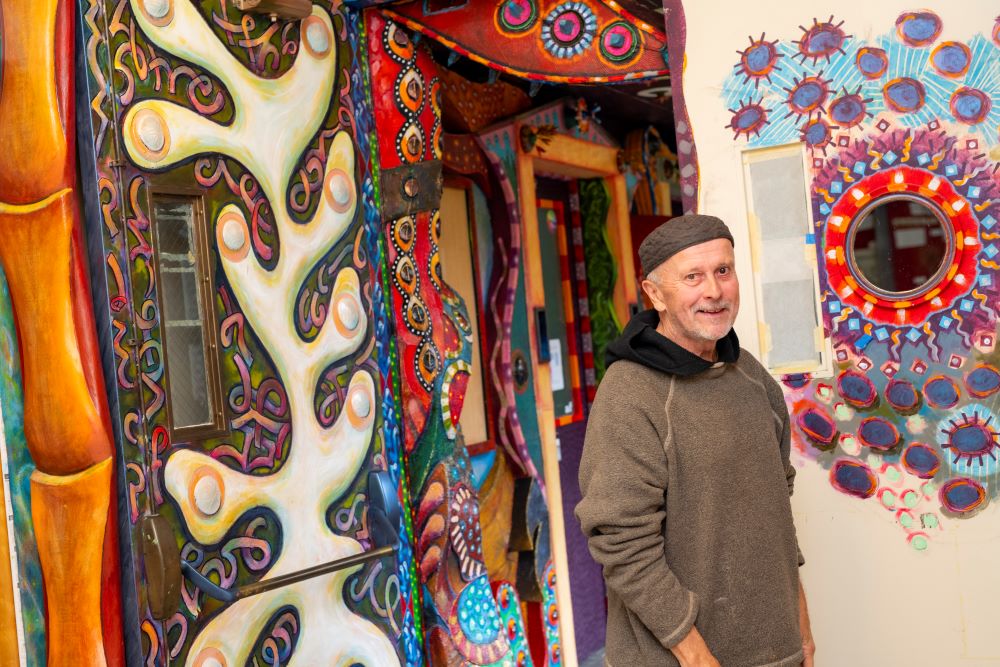This spring, David White (‘87, Art, ‘89, M.A. Art) was back on campus—paintbrush in hand, refreshing a legacy that’s grown for more than three decades. He came, as he always does every 10 years, to care for the space he created: the art hallway.
What began as a quiet artistic gesture by White in 1989 has become one of Cal Poly Humboldt’s most beloved, living works of art. Known by generations of students, faculty, and alumni simply as "the art hallway," this immersive, evolving installation transformed a once-ordinary corridor into a place of wonder.
Originally meant to be temporary, the colorful biomorphic installation is now a highlight of campus tours. It’s even got its own Facebook page.
White first began creating the art hallway while completing his Master of Arts degree at Humboldt. The installation, he says, was an extension of a show, titled Davood’s Garden, in a gallery just down the hall.
As he puts it, “The hallway just beyond the gallery felt like a natural progression of the exhibition.”
One night, he quietly installed a handmade door frame around the office of Art Professor Don Anton—the first seed planted in what would become a sprawling creative ecosystem.
With Anton’s support, one doorway became two, then more. And it just grew, he explains.
The campus community took notice. “The professors realized how uplifting it was for other students to come through it and see what you can do—that you can make art out of all kinds of stuff, anything around you,” White says.
Now, 35 years later, the hallway has become a place not just to view art, but to be inside it. Rounded doorways, a bench shaped from salvaged wood, hand-built curves softening the building’s rigid lines—these are invitations to slow down, to breathe.
“When I first came here, there were just two chairs,” he says. “I built a bench so people could sit. It became a place to pause, maybe even close your eyes.”
The installation, White explains, was his way of breaking up the monotony of stark white hallways and 90-degree angles with gentle curves, organic textures, and deeply personal details. Snakes wind subtly through the design, alongside flowers crafted by his daughter Hillary, also an artist, and mementos collected from his travels. One of his favorite elements is a former bulletin board—once a space for campus flyers and posters, it’s now transformed into a tribute. It bears the names of fellow artists, and custodians who became stewards of the work, tending to it with care over the years, dusting and protecting it, and former professors.
One of those faculty members was Art Professor Mark Johnson, a mentor to White.
“[David’s installation] is an exciting addition to the architecture of the art building and helps transform the bland institutional architecture to a fun house of exuberance and vitality, which is more appropriate to the feelings one associates with an art department,” said Johnson in a 1989 interview with The Lumberjack.
While working on the hallway remains a fond memory from his time at Humboldt, the freedom and support White received from professors such as Johnson and Anton were impactful. He never felt boxed in as an artist and was able to work in various mediums.
After graduating, White spent nearly two decades in Japan, teaching English by day and making art by night. He worked in old factory spaces turned galleries, designing walkways and immersive exhibits. One of his 1998 exhibitions in Tokyo drew families and curious locals in impressive numbers. “A curator told me, ‘I’ve never seen so many people come back to a show,’” White remembers.
Now based back in Humboldt County, White works as a carpenter and continues to create art—sometimes small wooden sculptures of people or creatures, a foot or two tall.
“I’ve been working with wood since I was five,” he says.
He finds constant inspiration in materials around him, working with mediums including paint, metal, and whatever he can get his hands on. “Even when I’m mowing or cutting, I’m thinking about how things are shaped,” he says.
As White’s skills evolve, so does the art hallway. He’s spent thousands of hours creating the installation, which he updates every decade or so, cleaning, repainting, and adding new touches.
“We’re always updating, building on, changing, improving,” he says. “It’s amazing how respectful people have been. I love watching it grow like a plant in the woods. The work tells me what it wants and needs. There’s so much joy in working this way.”
For White, the art hallway has always been about joy, curiosity, and connection.
To the students walking through it today—and those still to come—White offers this piece of advice: “Don’t let things be so precious that you are afraid to make changes. Even when you make stuff and it feels like it's a mess, learn from that. Every mess will give you ideas and what to do next time. It’s a process.”
He never imagined his installations would still be standing decades later, or that they’d become a destination.
“The art hallway gives people relief from the square, 90-degree white walls. All of a sudden, people of all ages are smiling. I love to share the joy of making public art that provides relief in such difficult times,” White says.
Photo: David White says there are so many reasons why he spends his time and money building artworks like the art hallway.

